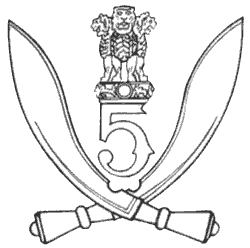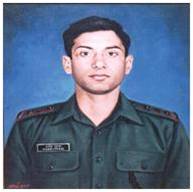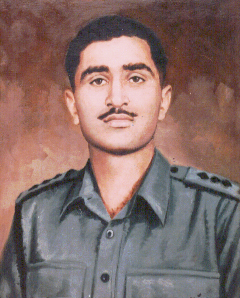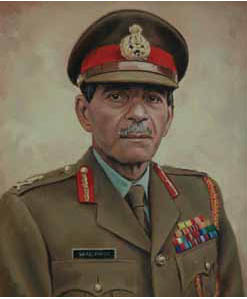
The 4th Indian Infantry Division, also known as the Red Eagle Division, is an infantry division of the Indian Army. This division of the British Indian Army was formed in Egypt in 1939 during the Second World War. During the Second World War, it took part in campaigns in East Africa, Syria, North Africa and Italy. Post independence, the division is part of the I Corps and headquartered at Prayagraj.

The 11 Gorkha Rifles is a Gorkha regiment of the Indian Army that was re-raised after independence. The regiment consists of primarily the Kirant Tribes Rai, Limbu, Yakkha, Sunuwar of Eastern Nepal, Darjeeling, Kalimpong, Dooars of West Bengal, Sikkim and other parts of Northeast India. Though it is considered to be the youngest of the Gorkha regiments its lineage is as long as those of the 7th Gurkha Rifles and 10th Gurkha Rifles.

The 4th Gorkha Rifles or the Fourth Gorkha Rifles, abbreviated as 4 GR, is an infantry regiment of the Indian Army comprising Gurkha soldiers of Indian Gorkha or Nepalese nationality, especially Magars and Gurungs hill tribes of Nepal. The Fourth Gorkha Rifles has five infantry battalions. The regiment was raised in 1857 as part of the British Indian Army. In 1947, after India's independence, the Fourth Gurkha Rifles became part of the Indian Army as the Fourth Gorkha Rifles.

Field Marshal Sam Hormusji Framji Jamshedji Manekshaw, also known as Sam Bahadur, was the chief of the army staff of the Indian Army during the Indo-Pakistani War of 1971, and the first Indian Army officer to be promoted to the rank of field marshal. His active military career spanned four decades and five wars, beginning with service in World War II.

5th Gorkha Rifles, also abbreviated as 5 GR(FF) is an infantry regiment of the Indian Army comprising Gurkha soldiers of Nepalese origin. It was formed in 1858 as part of the British Indian Army. The regiment's battalions served in the First World War (Mesopotamia) and Second World War.

Captain Manoj Kumar Pandey, PVC was an Indian military officer posthumous recipient of India's highest military decoration, the Param Vir Chakra, for his audacious courage and leadership during the Kargil War in 1999. An officer of the first battalion in the 11th Gorkha Rifles, he died in battle on the bunker hill edge of the Khalubar Hills in the village of Garkon Aryan Valley in Kargil.

Lieutenant Colonel Dhan Singh Thapa PVC was an Indian Army officer, and recipient of the Param Vir Chakra, India's highest military decoration. Thapa was commissioned into the 1st Battalion, 8 Gorkha Rifles in 1949.

Captain Gurbachan Singh Salaria, PVC was an Indian Army officer and member of a United Nations peacekeeping force. Salaria was an alumnus of King George's Royal Indian Military College and the National Defence Academy (NDA). He was the first NDA alumnus and is the only UN Peacekeeper to be awarded a Param Vir Chakra (PVC), India's highest wartime military decoration.

The 10th Indian Infantry Division was a war formed infantry division of the Indian Army during World War II. In four years, the division travelled over 4,000 miles (6,400 km) from Tehran to Trieste, fought three small wars, and fought two great campaigns: the Anglo-Iraqi War, the Invasion of Syria–Lebanon, the Anglo-Soviet invasion of Iran, the North African Campaign, and the Italian Campaign.

Lieutenant General Sagat Singh, PVSM was a General Officer in the Indian Army, notable for his participation in liberation of Goa and later in Indo-Pakistani war of 1971. He held many commands and staff appointments throughout his career.

Since the independence of India in 1947, as per the terms of the Britain–India–Nepal Tripartite Agreement, six Gorkha regiments, formerly part of the British Indian Army, became part of the Indian Army and have served ever since. The troops are mainly from ethnic Gurkha communities of India and Nepal. A seventh Gorkha Rifles regiment was re-raised in the Indian Army after Independence to accommodate Gorkha soldiers of the 7th Gurkha Rifles and the 10th Gurkha Rifles who chose not to transfer to the British Army.

The 8th Gorkha Rifles is a Gorkha regiment of the Indian Army. It was raised in 1824 as part of the British East India Company and later transferred to the British Indian Army after the Indian Rebellion of 1857. The regiment served in World War I and World War II, before being one of the six Gurkha regiments transferred to the Indian Army after independence in 1947. Since then it has served in a number of conflicts including the Sino-Indian War of 1962 and the Indo-Pakistan wars of 1965 and 1971. Today the 8th Gorkha Rifles is one of the most celebrated regiments of the Indian Army, having received numerous citations for bravery in the field of battle, and even producing one of the two field marshals of India, Field Marshal Sam Manekshaw, of the Indian Army.
The Battle of Sylhet was a major battle fought between the advancing Indian Army and the Pakistani Troops at Sylhet during the Bangladesh Liberation War. The battle took place 7 December and 15 December and was the Indian Army's first heliborne operation. It was a succession of the Battle of Gazipur in Kulaura.
Lieutenant General Zorawar Chand 'Zoru' Bakshi PVSM, MVC, VrC, VSM was a General Officer of the Indian Army, most widely known as one of the commanders of Indo-Pakistani War of 1965. He also has the distinction of being "India's most decorated General".
Lieutenant General Faridoon Noshir 'Billy' Billimoria, PVSM (1933–2005) was an Indian Army officer who was the 15th General Officer Commanding-in-Chief Central Command. He commanded a battalion in the Indo-Pakistani War of 1971. He was also the commandant of the Defence Services Staff College in 1986.
The 5th Battalion the 4th Gorkha Rifles, is an infantry battalion of the 4 Gorkha Rifles, a Rifle regiment of the Indian Army. The 5th Battalion the 4th Gorkha Rifles (GR), was raised in January 1963, in the wake of the Chinese Offensive, in Arunachal Pradesh, and Ladakh, India, from bases in Tibet, in 1962.
Lieutenant General Kashmir Singh Katoch, MC was an Indian Army General and military adviser to the Maharaja Hari Singh of Jammu and Kashmir, officiating as the Chief of Staff of the State Forces during the Indo-Pakistani War of 1947. He later served as the Vice Chief of Army Staff of the Indian Army.

Lieutenant General Walter Anthony Gustavo 'WAG' Pinto, PVSM was a General Officer in the Indian Army. He last served as the 8th General Officer Commanding-in-Chief of the Central Command. As a major general, he led the 54th Infantry Division on the western front in the Indo-Pakistani War of 1971, for which he was awarded the Param Vishisht Seva Medal.
Major General Anant Singh Pathania MVC, MC was a decorated Indian Army general; the first Indian to receive a Military Cross in the Second World War, he was also the first Indian commanding officer of the Gorkha Rifles. During the Sino-Indian War of 1962, he commanded the 4th Infantry Division during a critical stage of the conflict where his leadership was criticised.

Major General Siri Kanth Korla, PVSM, DSO, MC was a general officer in the Indian army who served in the Second World War and the Indo-Pakistan War of 1965. He served in the British Indian Army from 1934 to 1947, and the Indian Army from 1947 to 1971. Korla was known as one of the great company commanders of the Burma Campaign, and among the most highly decorated Indian officers of the British Indian Army during the Second World War.














